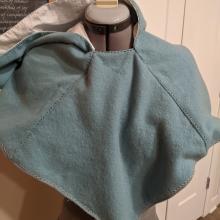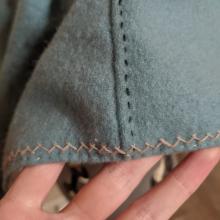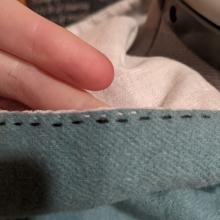This hood is recreation of the hood found in the Skoldehamn find. A Norwegian textile find dated to the 11th century. The site is a grave belonging to a male.
The hood from the find was made from light brown wool fabric. The hood fabric was of a denser weave than the other textiles found in the grave and consisted of four pieces: two rectangles on the side and two squares forming the front and back. Pieces were sewn together with linen thread.
To construct this hood, I used a woven wool fabric, waxed linen thread, linen to line the hood, and woolen thread for seam treatments on the seams.
For tools, the shears I used to cut the fabric and thread were of an early period design, however I used modern steel needles.
The wool I have used is blue rather than brown, I did this since the finished piece will be a gift and the recipient is partial to blue. There is also no evidence of seam treatments on the original, however this was a common technique for adding decoration and reinforcing seams in Norway. Both the herringbone and running stiches used for seam treatments on this hood have been found at other Scandinvivan archeological sites namely Hedeby and Mammen.
This recreation is 100% hand sewn. All seams are done with a mixed running backstitch in waxed linen thread. Hems are closed with a whip or felling stitch also in waxed linen thread.
I assembled the liner in full and the woolen hood then sewed the two together. Seam treatments were completed once the woolen portion of the hood was assembled. I used this order to ensure that the outer seams were secured before joining the layers. This allows the lining to protect the knots of the decorative stitching for increased longevity.
Viking Dress Code, Textile and Leather Clothing in Scandanvia. Kamil Rabiega. Triglav 2019




